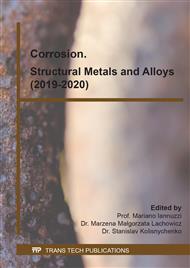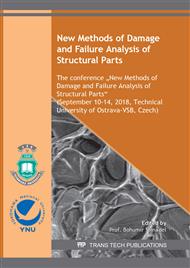[1]
F. Liu, T. Shinohara, Y.T. Su, Effects of electrode potential and cold work on propagation of SCC cracks of stainless steels in chloride solution, 60th Jpn. Conf. on Mater. and Environments (2013) B-106.
Google Scholar
[2]
W.F. Flanagan, P. Bastias, B.D. Lichter, A theory of transgranular stress-corrosion cracking, Acta metal. Mater., 39 (1991), 695-705.
DOI: 10.1016/0956-7151(91)90138-q
Google Scholar
[3]
E.I. Meletis, R.F. Hochman, A review of the crystallography of stress corrosion cracking, Corrosion Science, 26 (1986), 63-90.
DOI: 10.1016/0010-938x(86)90124-1
Google Scholar
[4]
M. Marek, R.F. Hockman, Crystallography and kinetics of stress corrosion cracking in type 316 stainless steel single crystals, Corrosion, 27 (1971), 361-370.
DOI: 10.5006/0010-9312-27.9.361
Google Scholar
[5]
R. Liu, N. Narita, C. Altstetter, H. Birnbaum, E.N. Pugh, Studies of the orientations of fracture surfaces produced in austenitic stainless steels by stress-corrosion cracking and hydrogen embrittlement, Metall. Trans. A 11A (1980) 1563-1574.
DOI: 10.1007/bf02654520
Google Scholar
[6]
T. Nakamura, S. Tsujikawa, Y. Hisamattype tress corrosion cracking test using notched round bar specimen of type 304 steel in H2SO4-NaCl solution, J. Jpn. Inst. Met. Mater., 46 (1982), 503-508.
Google Scholar
[7]
M.A. Astiz, An incompatible singular elastic element for two- and three- dimensional crack problems, Inter. J. Fracture, 31 (1986), 105-124.
DOI: 10.1007/bf00018917
Google Scholar
[8]
J. Toribio, N. Álvarez, B. González, J.C. Matos, A critical review of stress intensity factor solutions for surface cracks in round bars subjected to tension loading, Eng. Failure Analysis, 16 (2009), 794-809.
DOI: 10.1016/j.engfailanal.2008.06.023
Google Scholar
[9]
G. Nakayama, Y. Sakakibara, T. Fujii, Y. Shimamura, K. Tohgo, The contribution of the fracture mechanics for testing method which evaluates stress corrosion cracks initiation to propagation process, J. Soc. Mater. Sci. Jpn., 59 (2010), 890-899.
DOI: 10.2472/jsms.59.890
Google Scholar
[10]
M. Morita, O. Umezawa, A modeling approach to evaluate grain interaction induced by {111}<110> planar slips in face centered cubic polycrystalline materials, ISIJ International, 52 (2012), 1153-1161.
DOI: 10.2355/isijinternational.52.1153
Google Scholar



